The Ultimate Sewing Machine Shopping Guide
*This post may include affiliate links, which allow me to make a small commission off your purchases. The money is earned at no additional cost to you.
This sewing machine shopping guide is sure to help you find the best sewing machine for your needs. In addition to this guide, I have a YouTube video outlining all the sewing machines I’ve owned.
Let’s face it, no machine is going to be perfect!
Each machine has its own strengths and weaknesses. So, you must prioritize by deciding what feature(s) would best support your sewing goals. The sew goals for a garment maker, embroiderer, quilter, or bag maker are all going to be very different. So, for these 4 individuals, you are all going to need different types of machines.
Avoid the Gimmicks.
Beginners often look for machines with many stitches. However, 90% of sewing enthusiasts only use a straight or zigzag stitch for everyday sewing. For sewing knits, you don’t need a triple straight stitch to get the job done. Instead, its best to just decrease the stitch length and/or change the bobbin to a matching wooly nylon thread. For the trickiest knits, just use a zigzag!
What about those of us who don’t own a serger? Don’t we need an overcast stitch for garment making?
Edge finishing is very important because it increases the longevity of your garments. Overcast stitches save time. However, they don’t have the same professional appearance of other edge finishing methods. Plus, these overcast stitches don’t have the same longevity as a serger stitch. When you don’t own a serger, its always best to use couture, long lasting edge finishing methods such as:
- French Seams
- Bias tape binding
- Turned under edges
- Hem tape (lace or otherwise)
Other Gimmicks
Multiple stitches aren’t the only gimmick that can distract you from paying attention to the most important details. Other convenient but unnecessary features to consider are:
- Automatic thread cutters : You’ve already got to reach up to hit the button. So, reaching up to snip the threads with your thread snips shouldn’t take that much more time.
- Needle Up/Down: The needle can already stop up or down. It simply depends on when your foot comes off the pedal.
- Additional lighting: Additional lighting strips can be purchased for $10 or less. Whereas, I’ve seen machines marked up $500+ simply because they include more lighting.
- Invisible bobbin cover/computerized bobbin indicators: Bobbin indicators tend to never let you sew to the end of the bobbin. So, you just end up with a bunch of wasted thread. On the other hand, an invisible bobbin port will always be covered with fabric. Thus, it still will take a concentrated effort to look and see how much thread is left. Your better off just sewing to the end of your bobbin!
- Heavy Duty: Home brands try to sell buyers on “heavy duty.” But if they must say, “My machine is heavy duty,” please note the machine is not made for sewing handbags or other leather goods. The truth is home machines are only made for the occasional jump over jean material. They simply won’t do much else.
- Laser guides: A $6 Harbor Freight laser guide can be attached to your sewing machine in 5 minutes. So, please don’t go make a car payment on a sewing machine just because it has a laser built in.
- Projector: I must admit, it is pretty George Jetson to see an actual projector installed into a sewing machine. Such a feature would definitely help with free motion quilting projects. However, it’s really not a necessity to have this feature on a sewing machine.
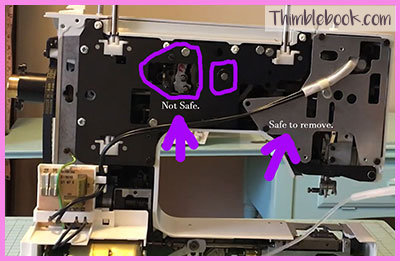
The #1 Feature everyone needs to look for is ease of sewing machine service.
Always look for a machine brand with many service and repair shops in your local area. Then, call to see how much it will cost to get the machine serviced. Also, check online to see how much replacement parts costs.
Once you’ve done the initial homework, check online to see if there are any service manuals or repair videos. This search will allow you to see if the machine is going to be easy enough to maintain beyond your initial investment. All of this research is important because nobody wants to spend a lot of money on a piece of equipment that can’t be repaired.
Garment Maker Sewing Machine Shopping Guide
When you are looking for a garment making machine, please ignore the gimmick and stick to the basic features below. There are some pretty good domestic home sewing machines on the market.
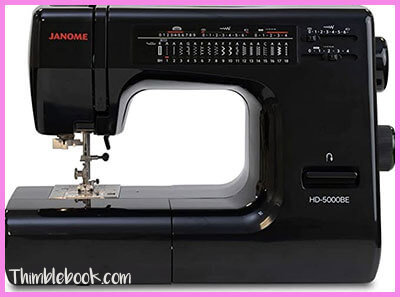
Janome HD 5000 has a stitch length of 7mm. It an also stitch thru some pretty thick materials.
Stitch quality: You always need to have excellent stitch quality in a sewing machine. This is what will give you that professional look. So, please don’t buy a sewing machine without seeing what the stitches look like.
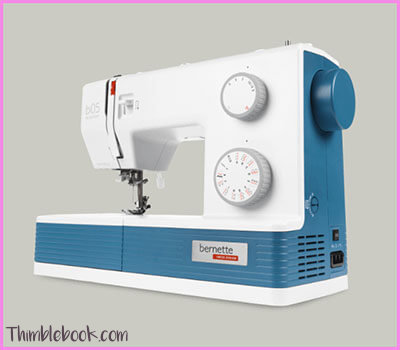
Bernette B05 has 12 included presser feet and an amazing speed of 1110spm.
Speed: The faster your sewing machine can go, the more projects you’ll be able to complete. Aim for 1000SPM. Yes, it will cost a more, but it’s well worth it. If you cannot afford to go faster, at least get something with a speed of 800SPM.
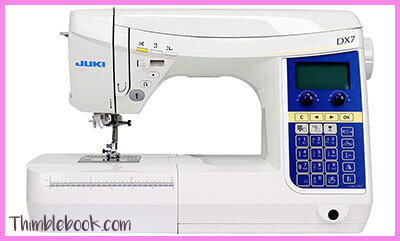
Juki HZL-DX7 has a speed of 1050SPM and many of those “unnecessary” bells and whistles. It isn’t a must to have the best features, but this machine certainly doesn’t disappoint.
Nice Buttonholes: While it is alright to do manual buttonholes, it is nice to have a sewing machine with a great buttonhole function. It is possible to find such greatness in a mechanical sewing machine. However, the most buttonhole variety comes from using a computerized machine.
Presser Feet Variety: Always pick a machine with a great selection of available presser feet. It will make your job so much easier.
Nice Needle plate: You need a needle plate that is not going to suck thin fabrics down into the machine. While some machines have a changeable needle plate, others have a single plate made with a narrow hole to accommodate many different types of fabrics.
Needle plate hole size is super important, but it is also very important to get a machine with at plate that has nice clear markings for easy stitching. Nice clear markings will make your sewing much easier. Likewise, consider getting a machine with a forward facing plate. This will allow you to use twin needles on knits and other garments for a more professional look.
Free Arm: A free arm isn’t a 100% must have. But, it does make getting round those necklines and armholes way easier.
Embroiderer Sewing Machine Shopping Guide
Multiple Stitches: You are the only exception to the “no need for additional stitches” suggestion. On a single needle machine, more stitch choices are always better for creating beautiful embroidery designs.
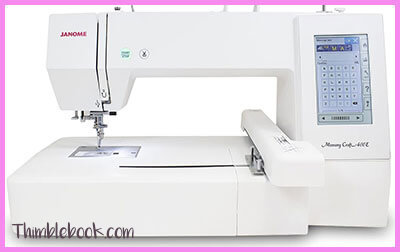
Janome 400E has a 7.9×7.9 embroidery window. This is a pretty big size for completing any project.
Embroidery Window: Always buy the biggest size embroidery window you can afford because it is very easy to outgrow 4×4. However, don’t feel bad for not being able to afford more than 4×4. After all, there are work arounds for stitching larger designs on a small machine.
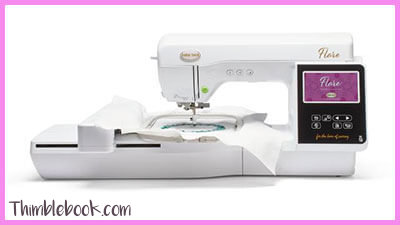
Babylock Flare is made by the same Brother manufacturer. Therefore, many of the very common Brother hoops will fit this machine.
Hoop Options: Select an embroidery machine with hoop variety and readily available embroidery hoops. After all, nobody wants to use a machine when there are no hat, small, large, or medium hoop options available.
File Type: Make sure the file type is common, especially when you are someone who buys embroidery designs online.
Speed: Dense embroidery designs can take forever to stitch out. Thus, it is always good to have a fast machine.
Multi-Needle: For a home embroiderer a single needle will do just fine. However, when you plan on making items for a small business, it is better to have a multi-needle machine. A multi-needle will indeed save you a lot of time on thread changes.
Quilter Sewing Machine Shopping Guide
When you are shopping for a quilting machine, please never loose site of the most important features!
Straight Stitch Quality: You really don’t need any other stitches on your machine. Seriously! Look at the stitch quality before making a purchase because stich quality is on full display in any quilted piece.
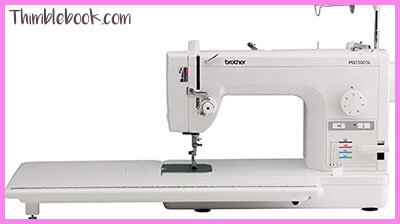
Brother PQ1500SL makes a beautiful straight stitch and has 1500spm.
Large Harp Area: This will allow you to easily fit those large quilts underneath.
Speed: A slow quilting machine will certainly become a great frustration . That’s why it’s very important to invest in a machine that will plow thru those quilting projects. The current speed average is between 1200- 1600SPM. While speed often equals additional costs, there are many good deals on the second hand market.
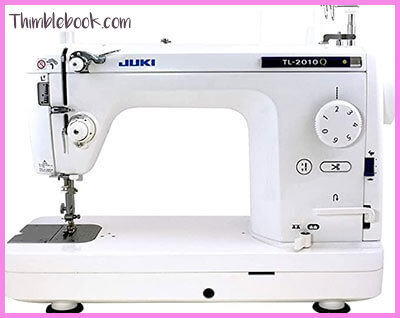
Juki 2010Q is a semi industrial machine ideal for quilting and small bag making tasks.
Strength: You need to get thru multiple layers of fabric. So, don’t go for a machine that isn’t up to the tasks!
Feed Dog Drop: Please don’t buy a machine without a feed dog drop. If you get a machine without the function, it will be painful to do free motion quilting.
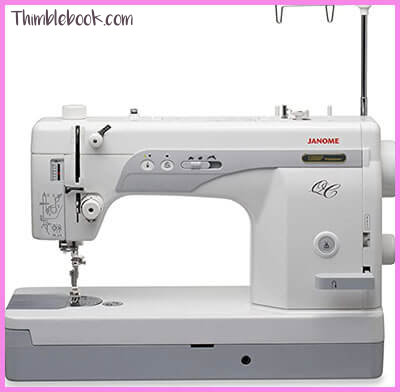
Janome 1600P is a quilting machine. But, it is often used for small bag making projects because it can handle big needles and thick thread.
Side or Front Bobbin Loader: You don’t want to take your entire quilt out from under the machine just to change out the bobbin. So, make sure your machine has the side or front bobbin loading option for general convivence. It also wouldn’t hurt to have a machine with jumbo bobbins as an added bonus 🙂
Bag Maker Sewing Machine Shopping Guide
When your shopping for a bag making machine, always concentrate on its strength. Stronger machines tend to cost more and/or take up more space. However, the second hand market is an excellent place to look when you don’t have enough cash to get going.

Janome HD 5000 has a stitch length of 7mm. It can stitch thru some pretty thick materials. Also, it is good because much earlier versions of this model (Excel 23x, Excel 23L, Excel 18w) can be found in the second hand market for around $100. This isn’t a top pick, but it will allow you to get started on a limited budget.
*Also, it must be noted most bag makers try to start on cheap (Walmart) domestic machines only to find themselves very frustrated. Please do avoid buying these sorts of machines for bag making!
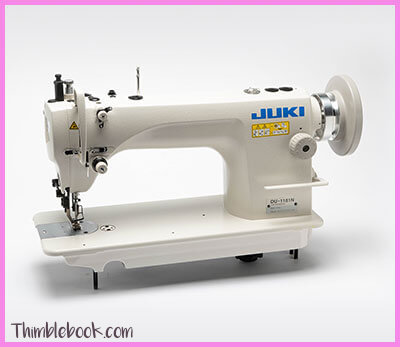
JUKI DU-1181N is the ideal machine for any bag maker. Due to its strength, it has become #1 for a number of bag making businesses.
Strength: You’ll want to power thru multiple layers of leather without a problem. So, look for a machine with a very robust motor. When in doubt, look online to see if there is an abundance of other makers using the same sewing machine for their bag making needs. An industrial machine is always going to be the best option for bag making and leather crafting. However, everyone doesn’t have the space for such. So, the next best option is a portable walking foot machine.
Here’s a few other top choices for industrial walking foot machines to consider:
Straight Stitch Quality: Most sewing machines are notorious for skipping stitches when they are required to stitch thru thick layers. Therefore, it is essential to see how straight stitch looks when applied to multiple layers of vinyl, leather, or denim before you make the commitment to any machine.

Initially designed for repairing boat sails, Reliable Barracuda 200ZW is robust. Though not strong as a dedicated industrial, it is good enough for you to get by.
Walking foot: Some machines have walking foot attachments. But, walking foot attachments don’t function the same way as a true walking foot machine. A walking foot machine should always be given first priority over other standard sewing machines. However, there are some instances where people do buy quilting machines to use for bag making during sewing retreats. As a quilter who makes the occasional bag, I would consider a semi industrial quilting machine. However, I wouldn’t consider it as a viable option for those who only make bags because prices are comparable to what you would pay for a dedicated bag/leather crafting sewing machine.
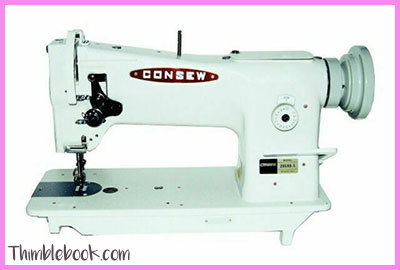
Consew 206RB-5 is yet another popular industrial walking foot machine. This particular model has a huge following.
Heavy Thread & Thick Needles: Make sure the manual gives specifics about heavy thread and thick needles. When the manual doesn’t say anything, it is an indicator the machine isn’t designed for your bag making usage. When in doubt, speak to a specialists at a sewing center to see what type of thread and needles your machine can handle.
Stitch Length: You’ll want and need to use a wider stitch length for creating beautiful top stitching. So, make sure the stitch length can at least get up to 6mm.
Last, and most importantly…
What are your must have features in a sewing machine? Please, let me know your thoughts in the comments section below.
Other Helpful Articles
2 Comments
Leave a response

I’m so glad you mentioned straight stitches. It’s hard to explain the difference between ok and beautiful. I’m keeping the 1959 Signature (M.Ward’s) I’ve been using since 1959. Dealing with Pfaff 1171 machines now. It died in the middle of a seam. The shop and everyone else say there’s no fix for a dead transformer on the circuit board. Just got a working 1171 from ebay. $ to get it working. Just read that servo motors have a definite life. Will never buy an electronic again. So I’ve been using a Kenmore 19412 to keep going. I totally agree. Ten stitches are plenty. Thanks for being out there!
Thanks for reading 🙂